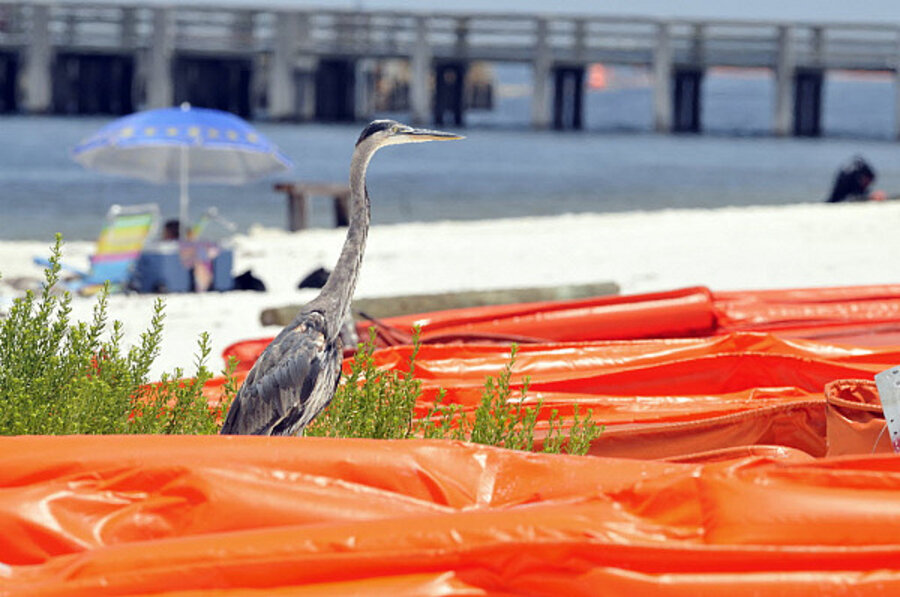Gulf oil spill: What's the impact on national parks?
Loading...
From Louisiana's Jean Lafitte National Historical Park and Reserve to the Canaveral National Seashore on Florida's space coast, the region's national parks and marine sanctuaries are preparing for the possible arrival of oil from the BP Deepwater Horizon blowout and Gulf oil spill, now into its eighth week.
So far, the the Gulf Coast National Seashore – a string of barrier islands and submerged ecosystems off Mississippi and the western shores of Florida's panhandle – appears to be the only National Park Service location in the Gulf region to take a direct hit from the burgeoning oil spill.
Even there, the oil's arrival has been patchy. The seashore's website proclaims that the park is still open to visitors. Where oil is coming ashore on the beaches, it arrives with the tide and ebbs with the tide, leaving residual oil that's fairly easy to clean up.
IN PICTURES: Places where the Gulf oil spill has made landfall
But with their legal mandate to preserve plants, animals, and marine life, as well as sites of historical value within their boundaries, park officials aren't waiting until oil laps at their beaches, marshes, and mangrove forests to lay plans for dealing with it.
Parks in the region "have done a fantastic job" gearing up for the the oil's possible arrival, says John Adornato, who heads the National Parks Conservation Association's "Sun Coast" regional office in Hollywood, Fla.
Yet, he acknowledges, preparations represent "a huge balancing act." Officials must weigh the use of skimmers, front-end loaders, and booms with the type ecosystems they oversee as well as the range of historical assets – from coastal forts and shipwrecks to archaeological sites – that could be damaged or destroyed by a well-meaning cleanup crew.
Lessons from the Exxon Valdez
The response represents a sea change compared with the National Park Service's response to the Exxon Valdez spill in Alaska's Prince William Sound in 1989. These days, responders have better communications tools, better data on the range and location of key habitats and cultural sites, and have worked out kinks in coordination among agencies involved in dealing with oil encroaching on parks.
One of the critical lessons: Time and distance may not protect parks "all that much," says John Quinley, an associate administrator in the park service regional office in Anchorage. Mr. Quinley currently is working out of the unified command joint information center office in Robert, La.
Initial relief that the Exxon Valdez spill occurred some 100 miles from Kenai Fjords National Park quickly evaporated once it became clear that the spill had defied efforts to keep the oil in the general area where the tanker ran aground. Eventually, the oil fouled coastal portions of three national park-related areas stretching some 400 miles from the spill, according to a report by then-park service historian Rick Kurtz.
The lesson hasn't been lost on parks in the Gulf region. Oil has been entering Louisiana's Barataria Bay, some 20 miles from the southern tip of Jean Lafitte National Historical Park and Preserve.
From the outset of the blowout April 20, employees have been taking a range of plant and water samples to provide a baseline for assessing any damage should oil work its way into the preserve – avoiding a shortcoming Dr. Kurtz's report highlighted in Alaska.
Much of that same data gathering has been underway at the five national parks in Florida, according to Linda Friar, spokeswoman for the Everglades National Park, headquartered in Homestead, Fla.
Canaveral National Seashore is the latest in the string of Florida National Park locations to set up contingency plans. The trigger for implementing them: the first tarballs clearly identifiable as Deepwater Horizon oil that wash up on the Dry Tortugas – something that has not yet happened.
Distance from the spill has given parks time to conduct the resource surveys they'll need for any cleanup or efforts to recover damages.
Sensitive habitats are one key concern.
"We have the world's biggest nesting ground for sooty terns on Bush Key," part of the Dry Tortugas National Park some 70 miles west of Key West, Fla., Ms. Friar says. "Should that island be affected, we would have to be very cautious about how we would clean it up."
It's a tiny island that is closed to the public, in large part because "the birds don't nest very well if there are lots of people walking around," Friar says.
Cultural resources need protecting
Beyond the birds are the cultural resources, which are sometimes more challenging to protect. Shell mounds, for instance, may not look like much to the casual visitor or to a front-end-loader operator, but they could well represent evidence of prehistoric cultures living in the area.
"We have to protect those for number of reasons," Friar says.
To ensure that clean-up efforts don't destroy such resources, park employees have been accompanying clean-up crews in oil-tainted areas to prevent damage to cultural sites. The Exxon Valdez clean-up effort led to the discovery of several archaeological sites within park boundaries that no one knew about before, Mr. Quinley says. Some of those were destroyed by the effort, as well. Indeed, in many instances, officials now say some of the cleaning techniques were more harmful than the oil.
Collectively, the parks in the Gulf region attract at least 8 million visitors a year, says the National Parks Conservation Association's Mr. Adornato.
For all the preparations, park representatives emphasize that they are still open for business. With the exception of the Gulf Islands National Seashore, no oil has yet tainted their boundaries.
IN PICTURES: Places where the Gulf oil spill has made landfall
Related:
BP oil spill spreads toward Pensacola, as wildlife toll rises





